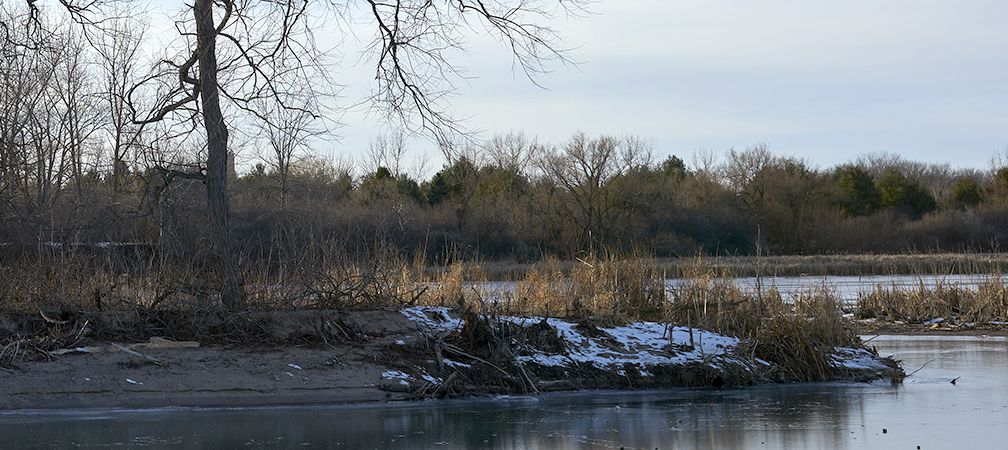Ontario Nature Blog
Receive email alerts about breaking conservation
and environmental news.
© Lora Denis
Red osier dogwood in winter wetland © Duncan Rawlinson
Without the chorus of birdsong and frog calls heard in warmer months, it’s easy to picture wetlands as vacant in the winter.
But appearances can be deceiving. Snow-blanketed ice transforms into a living guestbook wildlife sign with their feet. Barren trees become stopovers for visiting birds. A wetland in winter may be a quiet scene, but far from empty.
On World Wetlands Day, at a time when advocating for these vital habitats in Ontario is needed most, we invite you join our Youth Council in discovering the year-round value wetlands hold.

By Fiona Brown – a Youth Council member, United Nations Youth Constituency member and author.
The American cranberry bush (Photo a) is a large deciduous shrub that grows in wetlands and is famous for its clusters of bright red berries that are popular with many birds, particularly waxwings, starlings and migratory species.
In winter, red osier dogwood (Photo b) is an easily distinguishable shrub with bright red bark. Leading into winter, it produces red berries that are high in fat, which gives birds energy and insulation. Many species of birds rely on red osier dogwood for food or shelter including the American robin, blue jay and brown thrasher.
Staghorn sumac (Photo c) is a small deciduous shrub named for its branching pattern reminiscent of antlers. It is highly attractive to birds, especially during winter when its clusters of persistent fruit are vital food sources for many species including wild turkeys, finches and chickadees.

By Rosa Fragomeni – a Youth Council member who is passionate about sustainable development in her post-secondary education.
Each footstep on the wooden boardwalk echoes across a vast landscape filled with vegetation and ice-covered pockets of water. Loud footsteps on the wood beneath your feet separate you from the wetland. Beneath you, garbage and plastic food wrappers lay on the exposed soil. Even in a place that seems wild and free of human activity, pollution reaches every corner of nature. Further evidence of human activity is also present below. The buried petroleum pipeline beside the boardwalk transports a profitable commodity while keeping secret the risk of degrading local water quality. This risk remains despite efforts to safely dispose waste products and prevent interactions between pollutants and water.
Signs along the trail at Rattray Marsh highlight wetlands as a refuge for wildlife. Staghorn sumac, among other vegetation, is a visual sign of the food chain. Its bright red fruit supplies food and shelter for wildlife. Many animals, like birds, temporarily visit Rattray Marsh for a rest stop during their migration in spring and fall.
Wetlands act as carbon sinks. Carbon sinks absorb carbon dioxide that comes from nearby greenhouse gas sources such as vehicle and industrial emissions. Wetlands provide environmental advantages and serve as a reminder of the importance of protecting the quality of water bodies so all life can prosper, including us.
Thank you to Credit Valley Conservation and Authority’s website and signage for providing facts included in this text.

By Clara Brown – a Youth Council member who was named a Top 25 Environmentalist Under 25 by The Starfish Canada in January 2023.
Beavers don’t migrate or hibernate. They remain active in wetlands throughout winter living in their lodge, which can be viewed as a snowy mound with protruding sticks. Beavers build lodges of sticks and mud in wetland habitats; with an underwater entrance they enter and exit by swimming under the ice. Beavers store their food underwater, preserving it and keeping it and themselves safe under the ice, as they are slow-moving on land and susceptible to predation by wolves.
When not eating from their underwater food store, beavers eat the buds and outer bark of willow, alder, poplar and other shrubs. Gnawed trees or sticks that have been stripped of their bark can be more difficult to spot in winter due to frozen waterways and snow accumulation but are still visible.

If you can, go walking in a winter wonder-wetland this week to celebrate World Wetlands Day! You can start by visiting our nature reserves, three of which have accessibility features. Check out our Nature Reserves interactive map to find out which one is closer to you and use our new Winter Wonder-Wetland Guide to help guide your experience and observations.
By Maya Davidson & Ontario Nature Youth Council Members

Gananoque Lake Nature Reserve © Smera Sukumar
Thanks to all four of you for the informative articles above. In celebrating and defending nature, young people are not only our province’s future, they are also its present.